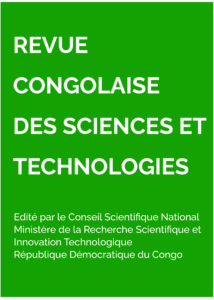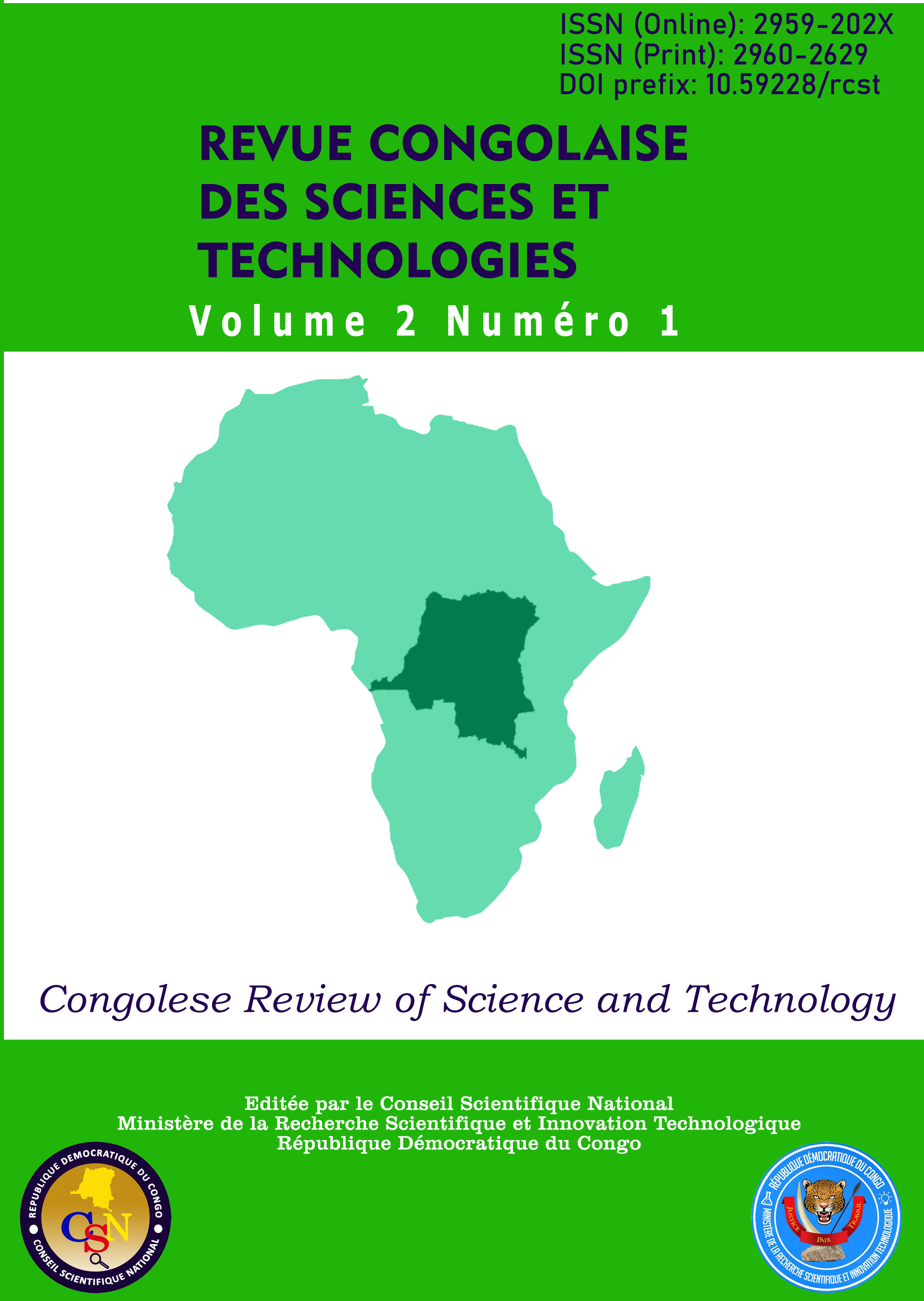The environnements impacts of eruptions volcanics in an era by the poor exploitation of current technological: case of province of the North Kivu in DR Congo
Main Article Content
Abstract
The purpose of this study is to analyze the prevalence; the impact on performance and the stress-generating problems among
Volcanism is one of the terrestrial phenomena naturel whose impact on the environment of our planet is more remarkable.
Let us recall that volcanism in the Virunga area, in the province of North Kivu in DR Congo, has its origin in the mechanism
of formation of mid-oceanic ridges meandering in the middle of the Atlantic and Indian Oceans with an extension in the
eastern part of the African continent.
Virunga volcanism is peculiar in three aspects: concentration of large volcanic edifices on a fairly small area; high frequency
of eruptive episodes and quasi-permanent lava lake activity.
The peculiarity of Virunga volcanism must generate, more than for other volcanoes, a more diversified range of
environmental impacts that we have identified in a non-exhaustive way below, following the lack of field investigations.
The identification of these impacts has led us to formulate some measures upstream of these eruptions in order to mitigate the
consequences of these eruptions and to encourage local populations to adapt to living with volcanoes.
Article Details

This work is licensed under a Creative Commons Attribution-NonCommercial-ShareAlike 4.0 International License.
References
Balagizi, M.C., Yalire, M.M., Kasereka, M., Kinja,
A., Kies, A. & Tedesco, D. (2011). An
overview of geohazards inside Goma City
and surrounding villages, North Kivu/the
DRC Congo [Conference]. European science
foundation conference, San Feliu de Guixols.
Balagizi, M.C., Darchambeau, F., Yalire, M.,
Bouillon, S., Borges, V.A. (2015). River
geochemistry, chemical weathering, and
atmospheric CO2 consumption rates in the
Virunga Volcanic Province (East Africa).
Geochem Geophys Geosyst, 16(8), 2637–
https://doi.org/10.1002/2015GC005999
Balagizi M.C., (2016). Identifying hydrological
pathways in the north basin of Lake Kivu
using stable isotope ratios of meteoric
recharge and surface water. In EGU General
Assembly Conference Abstracts (pp.
EPSC2016-9720).
Balagizi M.C., Kasereka, M.M., Cuoco, E. & Liotta,
M (2017). Rain-plume interactions at
Nyiragongo and Nyamulagira volcanoes and
associated rainwater hazards, East Africa.
Appl. Geochem., 81,76–89.
Beadle, L.C. (1981). The inland waters of tropical
Africa (2nd
edition). Longman, London.
Bobrowski, N., Giuffrida, G.B., Yalire, M., Lübcke,
P., Arellano, S., Balagizi, C., Calabrese, S.,
Galle, B. & Tedesco, D. (2016). Multicomponent gas emission measurements of the
active lava lake of Nyiragongo, DR Congo.
Journal of African Earth Sciences, 134, 856-
https://doi.org/10.1016/j.jafrearsci.2016.07.0
Borges, A.V., Abril, G., Delille, B., Descy, J.P. &
Darchambeau, F. (2011). Diffusive methane
emissions to the atmosphere from Lake Kivu
Eastern Africa. J Geophys Res, 116(3), 1–7.
https://doi.org/10.1029/2011JG001673.
Bourdier, J.L. (1994). Le Volcanisme. Orléans,
Editions BRGM.Carn SA, 2002, Eruptive and passive degassing of
sulfur dioxide at Nyiragongo volcano (D.R.
Congo): Acta Vulcanol 14(1–2):1–11
Cuoco, E., Tedesco, D., Poreda, R.J., Williams, J.C.,
De Francesco, S., Balagizi, M.C. & Darrah,
T.H. (2013). Impact of volcanic plume
emissions on rainwater chemistry during the
January 2010 Nyamulagira eruptive event:
implications for essential potable water
resources. J Hazard, 2012 : Mater ,244–
:570–584. https://
doi.org/10.1016/j.jhazmat.2012
Decket, R. & Decker, B. (1989). Volcanoes. New
York, W.H. Freeman and Company.
Degens, E.T., Von Herzen, R.P, Wong, H.K,
Deuser, W.G. & Jannasch, H.W. (1973).
Lake Kivu: structure. Nature 348:201.
https://doi.org/10.1038/348201a0
Deuser, W.G., Degens, E.T. & Harvey, G.R. (1973).
Methane in Lake Kivu: new data bearing its
origin. Science, 181, 51–54.
Fawell, J., Bailey, K., Chilton, J., Dahi, E., Fewtrell,
J. & Magara, Y. (2006). Fluoride in drinking
water. London, IWA Publishing.
Halbwachs, M., Tietze, K., Lorke, A. &
Mudaheranwa, C. (2002). Investigations in
Lake Kivu (east central Africa) after the
Nyiragongo eruption of January 2002:
Specific study of the impact of the sub-water
lava inflow on the lake stability. Paris,
Solidarité.
Kasereka, M.M., Yalire, M.M., Minani, A.S.,
Samba, C.V., Bisusa, A.K., Kamate, E.K.,
Mashagiro, N., Sauswa, M. et Kavuke, J.K.
(2017). Les risques liés aux mazuku dans la
région de Goma, république démocratique du
Congo (Rift Est-Africain). J. Water Environ.
Sci., 1(2), 164–174
Michel, D. (2011). Le Nyiragongo: volcan de tous
les dangers et maîtrise des risques. LAVE,
revue de l’association de volcanologie
européenne, 153, 16-29.
Ngindu, B.D. (2009). Mécanisme au foyer de
Grands Séismes du Rift des Grands Lacs
[Mémoire de DEA, Université Pédagogique
Nationale, R.D. Congo].
OMS. (2010). Glissement de terrain dans le village
de
Kibiriga, Zone de Santé de Karisimbi (Nord
Kivu) [Rapport de situation d’urgence].
Pouclet, A. (1975). Activités du volcan
Nyamuragira:Rift Ouest de l'Afrique
Centrale, évaluation des volumes de
matériaux émis.
Roussel, B. & Hirsch, B. (Eds.). (2017). Le Rift estafricain: Une singularité plurielle. IRD
éditions.Schmid, M., Halbwachs, M., Wehrli, B. & Wüest,
A. (2005). Weak mixing in Lake Kivu: new
insights indicate increasing risk of
uncontrolled gas eruption. Geochem.
Geophys. Geosyst. 6(7), 1–11.
https://doi.org/10.1029/2004GC000892.
Schmid, M. & Wüest, A. (2012). Stratification,
mixing and transport processes in Lake Kivu.
In J.P. Descy (Ed), Lake Kivu: limnology and
biogeochemistry of a tropical great lake, (pp.
–29). Berlin, Springer.
Tassi, F., Vaselli, O., Tedesco, D., Montegrossi, G.,
Darrah, T., Cuoco, E., Mapendano, M.Y.,
Poreda, R., & Huertas, D.A. (2009). Water
and gas chemistry at Lake Kivu (DRC):
geochemical evidence of vertical and
horizontal heterogeneities in a multibasin
structure. Geochem Geophys Geosyst, 10(2),
–22. https://doi.org/10.
/2008GC002191
Tazieff. (1975). Nyiragongo: le volcan interdit.
Paris, Editions Flammarion.
Tedesco, D., Tassi, F., Vaselli, O., Poreda, R. J.,
Darrah, T., Cuoco, E., & Yalire, M. M.
(2010). Gas isotopic signatures (He, C, and
Ar) in the Lake Kivu region (western branch
of the East African rift system): Geodynamic
and volcanological implications. Journal of
Geophysical Research: Solid Earth, 115(B1).
Doi:10.1029/2008JB006227
Vaselli, O., Capaccioni, B., Tedesco, D., Tassi, F.,
Yalire, M.M. & Kasereka, M. (2003). The
‘‘Evil’s Winds’’ (Mazukus) at Nyiragongo
volcano (Democratic Republic of Congo).
Acta Vulcanol, 14(1), 123–128
Verschuren, J. (1965). Un facteur de mortalite´ mal
connu, l’asphyxie par gaz toxiques naturels
au Parc National Albert, Congo. La Terre et
la Vie, 3, 215–237.
Yalire, M., Zaina, L., Baluku, B., Kasereka, M.,
Orlando, V. et Durieux, J. (2009). Etude de
l’impact de l’activite´ actuelle du volcan
Nyiragongo sur l’environnement de Goma en
R. D. Congo. Cahier du CERUKI, CRSNLwiro, numéro spécial.
Zana, N. & Wafula, M. (2020). The Virunga
volcanoes in DR Congo.

